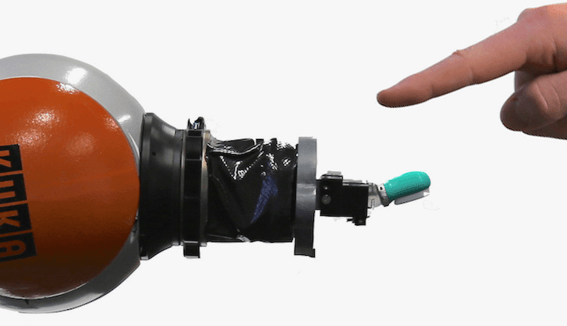Robots feel pain!
May 31, 2016
on
on

For robots, pain is an unknown sense. This insensitivity is also one of their major advantages in their inexorable progression to replace humans, It’s also one of their greatest failings in certain dangerous circumstances.
By allowing anything and feeling nothing, the robot can expose itself to great risk of being damaged or even being put out of service by an excess of zeal.
Armed with these observations, some German researchers are thinking about a kind of (rudimentary) nervous system for robots. Johannes Kuehn and Sami Haddaddin from the University of Leibniz at Hannover knew that pain is a functional signal in the nervous system that protects many living creatures. The reflex of withdrawal triggered by pain allows them to escape (sometimes serious) injury. The researchers have equipped a robotic arm Kuka with a digital BioTac (see below) fingertip sensor, and taking the human arm as their model, specifically the skin on the fingertips, they have made it sensitive to various sensations of pain.
If it is slight, their arm withdraws gently until the pain is gone, then it resumes its position. If it is moderate, the withdrawal of the arm is faster and it does not resume its previous position as quickly. In case of extreme pain, the robot runs the risk of being damaged and so passes into a passive mode to avoid further aggravation.
Without overstating this work, it can be seen as a sign of an evolution that – in time- will not fail to impress us much more.
The BioTac finger is not new, but its application is clever:
By allowing anything and feeling nothing, the robot can expose itself to great risk of being damaged or even being put out of service by an excess of zeal.
Armed with these observations, some German researchers are thinking about a kind of (rudimentary) nervous system for robots. Johannes Kuehn and Sami Haddaddin from the University of Leibniz at Hannover knew that pain is a functional signal in the nervous system that protects many living creatures. The reflex of withdrawal triggered by pain allows them to escape (sometimes serious) injury. The researchers have equipped a robotic arm Kuka with a digital BioTac (see below) fingertip sensor, and taking the human arm as their model, specifically the skin on the fingertips, they have made it sensitive to various sensations of pain.
If it is slight, their arm withdraws gently until the pain is gone, then it resumes its position. If it is moderate, the withdrawal of the arm is faster and it does not resume its previous position as quickly. In case of extreme pain, the robot runs the risk of being damaged and so passes into a passive mode to avoid further aggravation.
Without overstating this work, it can be seen as a sign of an evolution that – in time- will not fail to impress us much more.
The BioTac finger is not new, but its application is clever:
Read full article
Hide full article


Discussion (0 comments)